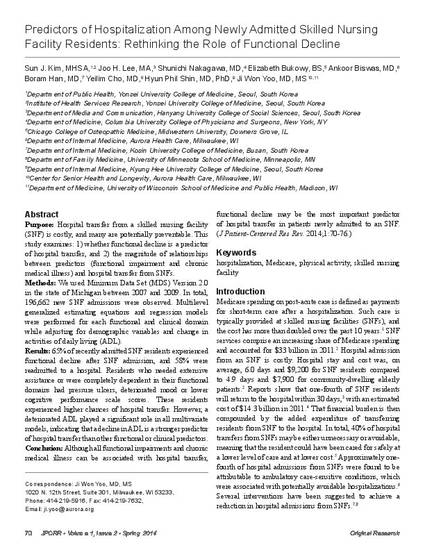
- hospitalization,
- Medicare,
- physical activity,
- skilled nursing facility
Purpose: Hospital transfer from a skilled nursing facility (SNF) is costly, and many are potentially preventable. This study examines: 1) whether functional decline is a predictor of hospital transfer, and 2) the magnitude of relationships between predictors (functional impairment and chronic medical illness) and hospital transfer from SNFs.
Methods: We used Minimum Data Set (MDS) Version 2.0 in the state of Michigan between 2007 and 2009. In total, 196,662 new SNF admissions were observed. Multilevel generalized estimating equations and regression models were performed for each functional and clinical domain while adjusting for demographic variables and change in activities of daily living (ADL).
Results: 65% of recently admitted SNF residents experienced functional decline after SNF admission, and 58% were readmitted to a hospital. Residents who needed extensive assistance or were completely dependent in their functional domains had pressure ulcers, deteriorated mood or lower cognitive performance scale scores. These residents experienced higher chances of hospital transfer. However, a deteriorated ADL played a significant role in all multivariate models, indicating that a decline in ADL is a stronger predictor of hospital transfer than other functional or clinical predictors.
Conclusion: Although all functional impairments and chronic medical illness can be associated with hospital transfer, functional decline may be the most important predictor of hospital transfer in patients newly admitted to an SNF.
Kim SJ, Lee JH, Nakagawa S, Bukowy E, Biswas A, Han B, Cho Y, Shin HP, Yoo JW. Predictors of hospitalization among newly admitted skilled nursing facility residents: rethinking the role of functional decline. J Patient Cent Res Rev. 2014;1:70-76. doi: 10.17294/2330-0698.1015
